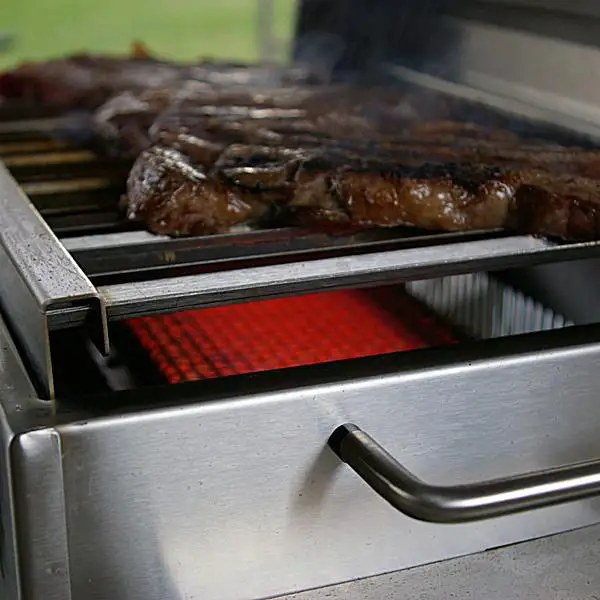Infrared gas grills harness the power of infrared technology to cook food. Instead of relying on an open flame or heated metal grates, these grills use infrared burners or plates that emit infrared radiation. This radiation heats the food directly, rather than heating the air surrounding it. This means faster cooking times, less flare-ups, and mouthwatering results. Infrared grills are known for their ability to quickly reach searing temperatures, giving you that perfectly caramelized crust on your steak or juicy flavor on your burgers.
An infrared gas grill works by using infrared burners instead of traditional burners. These burners produce intense heat that is then absorbed by a ceramic plate. The ceramic plate then radiates the heat evenly onto the cooking surface, providing quick and even cooking.
This method eliminates hot and cold spots and reduces flare-ups. Infrared grills are known for their ability to reach high temperatures quickly, making them excellent for searing and locking in juices. They also cook food faster while using less fuel compared to traditional gas grills.
How does an infrared gas grill work?
Infrared gas grills are becoming increasingly popular among grill enthusiasts. But how exactly do they work? In this article, I will explain the inner workings of an infrared gas grill and how it differs from traditional grilling methods.
-
Infrared gas grills use ceramic or metal plates to radiate heat directly onto the food.
-
The infrared heat is produced by burning propane or natural gas, which heats up the plates.
-
This method of cooking creates intense, even heat that sears the food quickly and locks in juices.
-
Infrared grills are known for their ability to reach high temperatures and cook food faster than traditional grills.
-
The heat is adjustable, allowing for precise control over the cooking process.
The Science Behind Infrared Heat
To understand how infrared gas grills work, we need to understand the science behind infrared heat. Infrared radiation is a form of electromagnetic radiation that falls between visible light and radio waves on the electromagnetic spectrum. It consists of invisible waves that transfer heat energy when they come into contact with an object.
When an infrared burner or ceramic plate is heated, it emits infrared heat waves that are absorbed by the food on the grill grates. This heat energy then penetrates the food, cooking it from the inside out. The food effectively becomes the heat source, resulting in faster and more efficient cooking.
Furthermore, the intense heat of infrared grills can reach extremely high temperatures, allowing for the searing and charring of food, which enhances flavors and creates visually appealing grill marks.

Advantages of Infrared Gas Grills
Infrared gas grills offer several advantages compared to traditional grilling methods. Here are some of the key benefits:
-
Rapid Heat-Up Time: Infrared grills can reach high temperatures in minutes, reducing the preheating time significantly.
-
Even Heat Distribution: The infrared heat ensures that the entire cooking surface is evenly heated, eliminating hot spots and cold zones.
-
Less Flare-Ups: The direct heat transfer of infrared grills minimizes flare-ups caused by dripping fat, reducing the risk of charring and uneven cooking.
-
Retained Juices and Moisture: The intense heat of infrared grills helps seal the juices and moisture inside the food, resulting in juicier and more flavorful meals.
-
Energy Efficiency: Infrared grills consume less fuel or energy compared to traditional grills, making them more environmentally friendly.
Maintenance and Cleaning
Like any other grill, infrared gas grills require regular maintenance and cleaning to ensure optimal performance and longevity. Here are some tips:
-
Regularly Clean the Grill Grates: Use a grill brush or scraper to remove food debris and grease from the grill grates after each use.
-
Clean the Infrared Burner or Ceramic Plate: Follow the manufacturer’s instructions to clean the infrared burner or ceramic plate regularly. Use a soft brush or cloth to remove any residues.
-
Inspect and Clean the Gas Burners: Check the gas burners for any obstructions or blockages. Remove any debris and clean the burners if necessary.
-
Empty and Clean the Drip Tray: The drip tray collects grease and fat drippings. Empty and clean it regularly to prevent buildup and potential fire hazards.
-
Store the Grill in a Protected Area: When not in use, cover the grill and store it in a dry and protected area to prevent damage from the elements.
What are the disadvantages of an infrared grill?
While infrared grills have gained popularity for their ability to provide high and even heat, there are some disadvantages associated with these grilling systems. It’s important to consider these drawbacks before deciding if an infrared grill is the right choice for you:
**Limited Cooking Area:
Infrared grills often have a smaller cooking area compared to traditional grills. This can be a disadvantage if you regularly cook for large gatherings or have a lot of food to prepare.
**Higher Cost:
Infrared grills are generally more expensive than traditional grills. The technology used in these grills, such as ceramic or stainless steel infrared burners, contributes to the higher cost.
**Learning Curve:
Using an infrared grill may require a learning curve. Achieving the perfect temperature and avoiding hot spots can be challenging for beginners. It may take some time to master the technique of cooking on an infrared grill.
**Limited Temperature Control:
While infrared grills can reach extremely high temperatures quickly, some models may have limitations in terms of low-temperature settings. This can be a drawback when you need to slow-cook or smoke certain dishes.
**Uneven Heating:
Despite claims of even heat distribution, some users report uneven heating on the cooking surface. Hot spots and cool zones can make it challenging to cook certain foods consistently.
**Not Ideal for Low and Slow Cooking:
Infrared grills are designed for high-temperature grilling, which makes them less suitable for low and slow cooking methods like smoking or slow roasting. Traditional smokers or grills may be better for these cooking styles.
**Limited Accessories:
Infrared grills may have fewer available accessories compared to traditional grills. This can limit your ability to customize and enhance your grilling experience.
**Harder to Find Replacement Parts:
If a component of your infrared grill needs replacement, finding specific parts may be more challenging compared to traditional grills, which are widely available and have a more established market.
**Potential for Flare-Ups:
Infrared grills can be more prone to flare-ups, especially when cooking fatty meats. While flare-ups are common in grilling, some users find it more challenging to manage on infrared grills.
**Maintenance Requirements:
Maintenance for infrared grills can be more involved. Keeping the infrared burners clean is crucial for optimal performance, and neglecting maintenance may lead to decreased efficiency over time.
While infrared grills offer rapid heating and even cooking, they come with certain drawbacks. It’s essential to weigh the advantages against these disadvantages to determine if an infrared grill aligns with your grilling preferences and cooking style.
Are Infrared Gas Grills Worth It?
If you’re a grill enthusiast looking for an efficient and high-performance grilling experience, then an infrared gas grill may be worth considering. The unique cooking technology provides numerous benefits, including faster cooking times, even heat distribution, and juicier meals. Additionally, the ability to achieve intense searing and charring makes it versatile for various grilling techniques.
However, it’s important to note that infrared gas grills tend to be more expensive than traditional gas or charcoal grills. They also require some additional maintenance and cleaning compared to other types of grills. Ultimately, the decision comes down to personal preferences and budget.
Frequently Asked Questions
An infrared gas grill is a type of grill that uses infrared technology to cook food. It uses a special burner that emits infrared radiation, which heats the food directly rather than relying on convection heat like traditional gas grills. This allows for faster and more even cooking, resulting in juicy and flavorful food.
3. Can I use an infrared gas grill for all types of food?
Yes, you can use an infrared gas grill to cook a wide variety of foods. It is particularly well-suited for grilling meats, such as steaks, burgers, and chicken, as the intense heat quickly sears the exterior, creating a flavorful crust while keeping the inside juicy. It is also great for grilling vegetables, seafood, and even pizzas.
However, it’s important to note that the intense heat of the infrared radiation may require slight adjustments in cooking times and temperatures compared to traditional gas grills. It’s always a good idea to refer to the grill’s instruction manual or recipe guides for specific cooking recommendations.
4. Are infrared gas grills easy to clean?
Yes, infrared gas grills are generally easy to clean. They typically have removable grates and drip trays, which can be easily cleaned with a grill brush and warm soapy water. The infrared burner itself may require occasional cleaning, but this can be easily done by gently brushing away any debris or residue.
As with any grill, proper maintenance and cleaning after each use will help prolong its lifespan and ensure optimal performance. It’s always a good idea to refer to the grill’s instruction manual for specific cleaning and maintenance guidelines.
5. Can I use an infrared gas grill indoors?
No, infrared gas grills are designed to be used outdoors only. This is because they produce high temperatures and emit flames during operation, which can be a fire hazard if used indoors. It is important to follow the manufacturer’s instructions and safety guidelines to ensure the grill is used safely and appropriately.
For indoor grilling, there are alternative options such as electric indoor grills or stovetop grilling methods.
An infrared gas grill uses a special technology that uses high-intensity heat to cook food quickly and evenly. Unlike traditional gas grills that use convection heat, an infrared grill uses infrared radiation to directly heat the food.
The grill has ceramic plates or burners that emit infrared heat, which is absorbed by the food and cooks it from the inside out. This results in faster cooking times and reduced flare-ups. The infrared heat also helps to seal in the juices, making the food more flavorful and moist.




